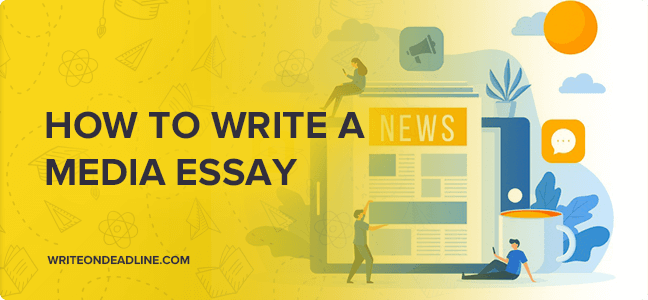How to Write a Media Essay

Table of Contents
Introduction
Definition and Purpose of a Media Essay
A media essay is a written analysis that offers a personal perspective on the significance of a particular piece of media. The purpose is to examine and interpret media, considering various elements like context, message, audience, and impact. It’s a tool to understand the role media plays in shaping perceptions and conveying information in contemporary society.
Importance of Media Analysis in Contemporary Society
Analyzing media is crucial in a world where information is omnipresent. It helps in discerning the underlying messages, identifying bias, and understanding the influence of media on public opinion. It fosters critical thinking and media literacy, empowering individuals to navigate through the digital age’s complex information landscape.
Understanding the Assignment
Deciphering Essay Prompts and Instructions
Begin by carefully reading the assignment prompt. Identify key terms, the scope of the analysis, and any specific requirements. Clarify any doubts with your instructor to ensure you’re on the right track.
Setting Objectives and Expectations for the Essay
Define what you aim to achieve with your essay. Set clear, measurable objectives that align with the essay prompt. Ensure your goals are realistic and that you have a plan for achieving them within the given timeframe.
Research and Analysis
Conducting Media Research Effectively
Start with a thorough literature review to understand the existing discourse on the media topic. Use reliable sources such as academic journals, books, and reputable news outlets. Organize your research systematically for easy reference during writing.
Critical Analysis of Media Content (With Examples)
Analyze the chosen media piece by looking at various elements:
- Content: What is being shown or told?
- Context: When and where is the media produced, and how does it affect the message?
- Audience: Who is the intended audience, and how might different audiences interpret the message?
- Purpose: What is the media’s goal? To inform, persuade, entertain, or sell?
- Techniques: What techniques are used to convey the message? Consider language, visuals, sound, narrative structure, etc.
- Impact: Assess the media’s influence. Has it changed opinions, incited action, or conveyed a significant message?
Provide specific examples to support your analysis. Use direct quotes, screenshots, or descriptions to illustrate your points effectively.
Remember to maintain a logical flow throughout your essay, transitioning smoothly from one section to another. Each part of your essay should build upon the previous, culminating in a comprehensive analysis that demonstrates a deep understanding of the media’s role in society.
Structuring the Essay
Outline of a Standard Media Essay Structure
-
Introduction
- Hook: Start with an engaging opening to draw the reader in.
- Background: Provide context for the media piece you’re analyzing.
- Thesis Statement: Present your main argument or perspective on the media’s impact or meaning.
-
Body
- Paragraph 1: Discuss the content and context.
- Paragraph 2: Examine the intended audience and potential interpretations.
- Paragraph 3: Analyze the purpose and techniques used in the media.
- Paragraph 4: Evaluate the media’s overall impact.
- Each paragraph should start with a topic sentence that states the main idea, followed by evidence and analysis.
-
Conclusion
- Summarize the key points made in the body.
- Restate the thesis in light of the discussion.
- Conclude with final thoughts on the media’s role or its broader implications.
How to Craft a Thesis Statement Specific to Media Essays
Your thesis should:
- Clearly state your position or argument regarding the media piece.
- Be specific and direct, avoiding vague language.
- Reflect the analytical nature of the essay, indicating the aspects of the media you will explore.
Writing the Essay
Paragraph Structure and Development of Arguments
- Topic Sentence: Start with a clear statement of what the paragraph will discuss.
- Evidence: Include specific examples from the media, such as quotes, scenes, or techniques.
- Analysis: Explain how the evidence supports your thesis and the paragraph’s topic.
- Conclusion: End with a sentence that ties the paragraph back to the thesis and provides a transition to the next point.
Incorporating Evidence and Citations
- Use evidence to back up each point you make.
- Cite sources properly using the required citation style (e.g., APA, MLA, Chicago).
- Include in-text citations whenever you reference a source directly or indirectly.
- Provide a bibliography or works cited page at the end.
Stylistic Considerations
Writing Styles and Tones Appropriate for Media Essays
- Maintain an academic tone, using formal language and avoiding slang or colloquialisms.
- Write in the third person unless personal reflection is specifically allowed or encouraged.
The Balance between Formal Analysis and Personal Reflection
- The essay should predominantly focus on formal analysis, dissecting the media piece with objective scrutiny.
- Personal reflections can be included but should be framed within the context of the analysis, linking personal viewpoints to academic arguments.
Editing and Proofreading
Strategies for Revising Drafts
- Take a Break: Step away from your essay before you begin revising to approach it with fresh eyes.
- Read Aloud: Reading your draft out loud can help you catch errors and assess the flow of your writing.
- Peer Review: Have someone else read your essay. They may catch mistakes you’ve missed and provide valuable feedback.
- Check Structure: Ensure each paragraph supports your thesis and that the essay flows logically.
- Focus on Clarity: Simplify complex sentences and clarify any ambiguous language.
- Refine Your Thesis: Make sure your thesis is clear and that the evidence throughout your essay supports it.
Grammar and Stylistic Errors to Avoid
- Passive Voice: Use active voice to make sentences clearer and more engaging.
- Run-On Sentences and Fragments: Ensure each sentence is complete and concise.
- Overuse of Jargon: Use technical terms appropriately, but don’t overload your essay with them.
- Comma Splices: Use conjunctions or semicolons to join clauses correctly.
- Consistency: Maintain tense and point of view throughout your essay.
- Overgeneralization: Support your statements with specific evidence.
Conclusion
Effectively Summarizing Arguments and Findings
- Restate your thesis in the light of the evidence you’ve presented.
- Summarize the main points of your analysis without introducing new information.
- Show how your findings contribute to the understanding of the media piece.
Providing Insightful Closing Remarks
- Offer thoughts on the implications of your analysis.
- Suggest areas for further research or questions raised by your essay.
- End with a strong, memorable final sentence that encapsulates the essence of your argument.

